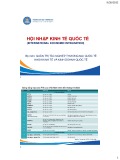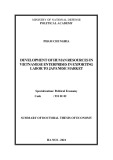VIETNAM ACADEMY OF SOCIAL SCIENCES GRADUATE ACADEMY OF SOCIAL SCIENCES -------------------- TRAN DINH HUNG
THE DEVELOPMENT OF SMALL AND MEDIUM-
SIZED ENTERPRISES IN GERMAN ECONOMY
IN RECENT YEARS
Major : International Economic
Code: 9. 31. 01. 06
SUMMARY OF DOCTORAL THESIS
HA NOI - 2020
This thesis has been completed at:
VIETNAM ACADEMY OF SOCIAL SCIENCES GRADUATE ACADEMY OF SOCIAL SCIENCES
Scientific Supervisors: Assoc.Prof. Nguyen Thanh Duc
Assoc.Prof. Dang Minh Duc
Examiner 1: Assoc. Prof. Trinh Thi Hoa Mai
Examiner 2: Assoc. Prof. Nguyen Nhu Binh
Examiner 3: Assoc. Prof. Pham Thai Quoc
The doctoral thesis will be defended at the GASS-level Board of
Examiners at:
…………………………………………………………………………………….
The doctoral thesis can be found at:
- National Library of Vietnam
- Library of the Graduate Academy of Social Sciences
1
INTRODUCTION
1. Rationale for the study
Small and medium-sized enterprises (SMEs) have long been seen
as having a crucial role in the economy of each country, whether it is
developed or developing. In Vietnam, SMEs development has
become one of the top priorities of the Government in recent years.
However, compared with its true potential, the SMEs have not yet
received adequate attention and there is still plenty of room for
growth. Determining the right role and understanding the important
position of SMEs in the economy is extremely important to propose
timely and correct support policies, to help Vietnam exploiting
internal resources, creating more jobs, promoting socio-economic
growth and contribute to more sustainable GDP growth.
The author of the thesis assesses that Germany is one of the
countries with developed SME sector, which is considered to have an
important role in maintaining the stable socio-economic development
that Vietnam can learn from. Firstly, SMEs in Germany account for a
large proportion in the economy with more than 99% of businesses,
employing about 60% of the workforce. These are mostly family
businesses, or more than 50% family owned, that typically specialize
in one product category. Secondly, SMEs are considered as the
backbone, making a great contribution to the stable development of
the German economy, accounting for about 52% of GDP, creating
jobs and solving unemployment, helping to enhance the
competitiveness of the economy. Thirdly, the German government
has made a great commitment to the SME sector through many
effective tools to ensure the interests of this business sector.
2
Research on the development of SMEs in Germany is necessary
and is seen as an opportunity for each country, including Vietnam, to
draw lessons from both theory and practice; thereby proposing
practical solutions in the process of implementing programs and
policies to support SME development in the economy. From all the
above reasons, the author of the thesis has chosen the research topic
entitled: "The development of small and medium enterprises in the
German economy in recent years".
2. Research aims and objectives
2.1. Research aims
Systematize theoretical issues about SMEs development, analyze
and evaluate the development of SMEs in the German economy from
the early 2000s to the present to figure out the advantages and
limitations that still exists as well as drawing out useful policy
recommendations for Vietnam.
2.2. Research objectives
Firstly, clarifying the theoretical basis for SME development.
Secondly, analyzing the current situation of SME development in
German economy; assessing the strengths and weaknesses, as well as
providing lessons learned from the actual development of German
SMEs; Thirdly, comparing the development of SMEs in the economy
between Germany and Vietnam, thereby drawing useful policy
recommendations for Vietnam in the coming time.
3. Objects and scope of the study
3.1. Objects of the study
3
The thesis focuses on analyzing the development of SMEs in the
German economy and the development of SMEs in Vietnam
economy.
3.2. Scope of the study
The thesis focuses on in-depth analysis of the development of
SMEs in the German economy since the early 2000s. Specifically,
the thesis divides the scope of time into three important milestones:
(1) the period from the early 2000s to before the world economic
crisis, when the German economy was faced with the labor crisis
under former Prime Minister Gerhard Schröder, unemployment
increased; (2) the period of the world economic crisis, when
Germany was one of the countries that suffered heavily on all socio-
economic aspects; and (3) the period in recent years when the
German economy returned to its growth trajectory. Along with that is
the growing influence of the 4.0 Industrial Revolution that is taking
place strongly, and Germany is one of the pioneers in the innovation
process.
4. The research method
The thesis uses synchronously scientific research methods such
as logical-historical, analytical-synthesis method. In addition, the
method of comparison, statistics, and descriptive analysis methods
are also effectively applied in the thesis in comparing the
development of SMEs in the economy between Vietnam and
Germany and highlight the research issues. The thesis accesses and
uses data from secondary documents that are systematic and from
reliable data sources, collected from reputable agencies in the country
as well as from the world.
4
5. Significance of the study
Firstly, the thesis systematizes the theoretical issues of the
development of SMEs. Secondly, the thesis has proven the SMEs
role as the backbone of the German economy through analyzing and
evaluating the situation of SME development in the Germany over
time; from there, assesssing the advantages and disadvantages in the
process of developing SMEs in Germany. Thirdly, the thesis draws
lessons from the actual SME development in the German economy
and provides useful lessons for the SME development process in
Vietnam.
The theoretical significance of the thesis: The thesis has
systematically presented theoretical issues about the development of
SMEs in the economy, clarifying the controversial definition of
SMEs, specifying the role of SMEs and clearly identifying the
influencing factors as well as formulating criteria to evaluate the
development of SMEs in the national economy.
Practical significance of the thesis: The thesis has assessed the
current situation of the development of SMEs in Germany from 2000
to present through each milestone. From there, analyzing the
advantages and disadvantages of the SME development process in
Germany as well as drawing lessons from the actual development of
SMEs in the German economy. The thesis compares the similarities
and differences between Vietnam and Germany in the process of
developing their own SME sector, drawing useful policy
recommendations for Vietnam in the coming time.
6. Structure of the thesis
5
The thesis includes four chapters:
Chapter 1: Literature review.
Chapter 2: Theoretical framework for the development of small
and medium-sized enterprises.
Chapter 3: Current situation of small and medium-sized
enterprises’ development in German economy in recent years.
Chapter 4: Current situation of small and medium-sized
enterprises’ development in Vietnam’s economy and policy
recommendations.
CHAPTER 1
LITERATURE REVIEW
1.1. Publications related to the thesis
1.1.1. Publications related to theoretical framework of the SMEs
There are two schools of thought that define SMEs: by
qualitative and quantitative standards.
Identifying SMEs according to qualitative standards is quite
difficult, therefore, countries often use quantitative standards.
There is no consensus in the definition between countries due to
the difference in economic conditions and levels…
1.1.2 Publications related to the role of SMEs
Creating jobs, reducing the unemployment rate;
Platform of the economy, promote growth;
To compensate for the shortage and promote limited resources in
the economy;
Great potential in innovation.
6
1.1.3. Publications related to the influencing factors and the State’s
supportive policies for SMEs
Internal factors: enterprise resources; business management
capacity; corporate culture; business development strategy.
External factors: regulatory environment; policy environment;
the role of the bussiness Associations; market competition.
1.1.4. Publications related to existing problems of SMEs
Access to capital, technology, skilled labor, difficult to enter the
market, affecting SMEs development.
1.2. Research gap and future research direction:
1.2.1. Contribution of previous studies:
Previously published studies have solved many theoretical and
practical problems related to the development of SMEs in the
economy.
1.2.2. The gap needs further research in the thesis:
There are not many fully systematized studies about the
theoretical issues such as concepts, classification, roles and the
impact factors, assessment criteria for SMEs development.
The previous studies mainly analyze SMEs in Europe in general,
few studies and assessments on the development of SMEs in German
economy.
The author of thesis found that there is still a lack of research
focusing on the period from 2000 to present about the experience of
developing SMEs in Germany, from that, to draw practical lessons
for Vietnam. In addition, there are not many studies regarding a
series of future difficulties that SMEs in Germany have to face, such
as generation crisis, the race of SMEs in the industrial revolution 4.0
which is happening more and more strongly.
7
CHAPTER 2
THEORETICAL FRAMEWORK FOR THE DEVELOPMENT
OF SMALL AND MEDIUM-SIZED ENTERPRISES
2.1. Theories of SMEs development
Penrose’s The Theory of the Growth of the Firm;
Resource-based view of the firm theory and dynamic
capabilities theory;
Greiner growth model;
Michael Porter’s competitive strategy.
2.2. Small medium-sized enterprises
2.2.1. Definition
Basing on qualitative standards:
SMEs have much simpler operations and structures than large
firms, low level of management complexity with few management
clues. They also operate according to personal principles and the
leader is usally the business owner.
Basing on quantitative standards:
The three criteria most commonly used by countries are based
on the firm's annual balance sheet, its annual turnover, and the
number of its employees. These criteria are not the same between
countries due to differences in economic and social conditions ... In
which, the criterion for determining SMEs in Germany is having less
than 500 employees and a turnover equal or less than 50 million
euros per year.
2.2.2. Characteristics of SMEs
SMEs often have a simpler and more flexible operating structure
and management method than large firms. The competitive position
8
of SMEs in the market is often unclear. SMEs also have limited
capital resources, often relying mainly on the equity resources of the
business owner. SMEs' ability to access loans from credit institutions
is also much weaker than large firms.
2.2.3. Roles of SMEs in the economy
SMEs create jobs, reduce unemployment;
SMEs are the foundation of the economy, promoting economic
growth;
SMEs help to compensate for the shortages and promote limited
resources in the economy;
SMEs have great potential for innovation.
2.3. Concepts, evaluation criteria and factors influencing SMEs
2.3.1. Concept of promoting SMEs
The concept of promoting SMEs has been popular since the late
1940s with the proposal of targeted policies including credit
subsidies, tax support ... as well as the establishment of specialized
government agencies to supporting SMEs to establish and develop.
From the previous conclusions, the author of the thesis believes
that promoting SMEs is a process to assist businesses in improving
production and business activities through increasing access to the
missing resources, improving the business environment, helping
young businesses easily enter the market, and operating businesses
can get favorable conditions for development, thereby re-contributing
to the national socio-economy.
2.3.2. Criteria for assessing SMEs development in the economy
Criteria for assessing SMEs development in the economy
include: the proportion of SMEs number in the economy; the
9
proportion of SMEs contribution in the economy; the share of
employment in SMEs sector; the rate of vocational training in SMEs.
2.3.3. Factors influencing SME development
Internal factors include: enterprise resources; business
management capacity; corporate culture; business development
strategy.
External factors include: the regulatory environment; policy
environment; the role of business associations; market competition.
10
2.4. Framework for analyzing the development of small and
medium-sized enterprises in the German economy
11
CHAPTER 3
CURRENT SITUATION OF SMALL AND MEDIUM-SIZED
ENTERPRISES’ DEVELOPMENT IN GERMAN ECONOMY
IN RECENT YEARS
3.1. An overview of the development of SMEs in German
economy
Although existed for a long time in the economy, it was not until
the 1970s of the twentieth century that the role of SMEs was
appreciated and gained great attention. At that time the German
economy was facing many worries such as decreased growth rate,
high unemployment rate in large enterprises due to technological
innovation, restructuring operations leading to job cuts, potential
risks including the risk of instability to the German labor market in
general and would gradually create a great burden on the economy. It
was during this period that the SME sector was expected to help the
economy solve labor problems, create jobs for workers who lost their
jobs, help stabilize production activities and promote national export
capacity. With the advantages of small scale, flexibility in operating,
and the recognition of the increasingly active role of SMEs by the
German Government, SMEs in Germany have risen strongly,
affirming an important position in the economy through many direct
and indirect contributions, specifically: job creation, reduction of
unemployment rate, promote start-up and self-employed trends,
vocational training in enterprises, promote import – export,
stabilizing East German and West German economies after
reunification.
12
As of 2003, there were 3.38 million SMEs in Germany
(accounting for 99.7% of the total number of enterprises nationwide),
employing 19.98 million workers (accounting for 70.2% of the total
number of employees), contributing 41,2% of total revenue in the
economy and provide vocational training programs for 81.9% of total
apprentice workers. In the early 2000s, the German labor market
experienced many waves. The unemployment rate tended to increase.
By December 2002, the number of unemployment registration
applications reached 4.16 million, an increase of 197,000 over the
previous year. The unemployment rate stood at 9,779% in 2003 and
peaked at 11,167% in 2005. The bleak economy, the rising
unemployment rate, and the heavy social spending burden required
Germany to make timely reforms in order to stabilize the situation.
3.1.1. SMEs development in the early 2000s
The Government was determined to implement a series of
comprehensive solutions to thoroughly reform the German labor
market and the difficult social welfare system. The core of this
program was "Hartz reform" to support workers out of
unemployment through vocational training subsidy programs, new
job placement, start-up support; in addition to restructuring Federal
Work Offices; reform of social assistance policies for the
unemployed ...
To achieve these goals, the German Government identified SMEs as
the key to maintaining economic stability, the main driver of many
jobs. Specifically, the German Ministry of Economy and Labor
issued the "Small and Medium Enterprise Initiative" in January 2003
to specifically support this business sector's development. The
initiative was also part of the German Government's 2010 Agenda
13
with six focused
issues: Promoting entrepreneurship; Ensure
financial support; Promoting vocational training, especially skilled
workers; Reducing barriers from bureaucratic procedures; Promoting
enterprise innovation; Promote investment and foreign trade
exchange.
In order to achieve the above objectives, the German
Government implemented a series of solutions, through specific
programs and policies to support SMEs, specifically: Regulating the
business environment; Developing a cultural and entrepreneurial
society; Promoting entrepreneurship in women; Help SMEs to access
international markets, access financial resources; Promote
development of e-commerce, innovation of technology for SMEs;
Human resource training for businesses.
With a series of synchronous solutions, the German Federal
Government, through the contributions of SMEs, achieved many
positive results, helping the economy gradually return to its trajectory
when GDP growth from the lowest level which was -0.714% in 2003,
rebounded to 1.19% in 2004, 0.722% in 2005 and peaked at 3,815%
in 2006 before showing signs of decline due to the effects of the
global economic recession in 2008. The German labor market
benefited when in the early 2000s, the unemployment rate increased
over the years and peaked at 11,167% in 2005, which tended to
decrease in the following years. This shows that the solutions of the
German Government have been effective and, in particular, the SME
sector has shown its role in helping to stabilize the labor market.
The position of SMEs in Germany is confirmed in the economy
when it still plays a role as a support to the economy, promotes
growth and plays a great role in creating jobs, reducing the
14
unemployment rate with the rate of enterprises account for 99.27% of
the total number of enterprises in the country, of which more than
58% of the national labor rate. In addition, the rate of annual revenue
contributing to the economy still maintains a significant market share
at 33.64%, especially the role in vocational training and labor
training is confirmed with 82.94%, helping to maintain sustainable
static of the labor market. In addition, SMEs also help promote
limited resources in the economy and have great potential for
innovation.
3.1.2. SMEs development in Germany during the world economic
crisis:
The global economic crisis caused damage to every country in
the world and Germany was one of the most heavily affected
economy. The German Government was then facing more
difficulties. GDP growth rate in 2009 bottomed out at -5,697%.
Export of goods and services decreased, accounting for only 38.12%
of GDP in 2009.
With more than 99% of them being SMEs, employing a large
number of workers in the economy, the German Government
understood that the role of SMEs was of utmost importance in
continuing to keep the economy stable. With the existing advantages
of this business sector such as small scale, adaptive flexibility,
flexibility in operation, skilled labor and the background of family
companies operating through generations, the German Government
adopted many supportive policies that gave priority to SMEs in
Germany to quickly restore production during the crisis to help
stabilize the socio-economic order.
15
First of all, to help ensure jobs for workers, stabilize business
operations, the Government reopened the program "Kurzarbeit" with
the aim of reducing working hours for employees. In this way,
businesses would still be able to maintain operations without cutting
labor, reducing the risk of unemployment burdens for society. Along
with that, the Government also through communication channels and
trade unions, widely advertised this campaign to workers to increase
awareness and sense of cooperation among workers with businesses.
Accordingly, the Federal Employment Agency would pay workers up
to two-thirds of the wages lost during the reduction of hours
compared to the past and would compensate between 50% and 100%
of the contribution to other social security contributions that the
business owner must pay. In addition, the Government also measured
to support the macro-economy such as introducing a series of
initiatives to stimulate economic activities in some areas, including
direct credit support to businesses, sponsored by KfW Central Bank,
subject to special interest in SMEs. The Government also constantly
innovated and promoted the creative and entrepreneurial spirit of
enterprises and entrepreneurs.
With the timely support from the German Government, the
SMEs in the economy gradually stabilized their production activities
and contributed to stabilizing the labor market. Confidence and
optimism from SMEs were back. In 2009, there were only 90,000 job
loss cases, a very small percentage of the SME workforce. In 2010, a
positive trend in new enterprise establishment was recorded, reaching
417,600 enterprises, an increase of 1.2% over the previous year.
Besides timely policies from the Government, the SMEs in Germany
also received strength from the European Union. Accordingly, the
16
Small and Medium Enterprises Act passed by the European
Commission in June 2008, expressed the expectation and reflected
the European Commission's political will to define the position and
the important role of SMEs in the EU economy.
Summarizing in the world economic crisis, although the
economy faced many difficulties, with a series of synchronous and
timely policy solutions before and during the crisis, the German
economy with SMEs as the backbone had quickly regained their
momentum of growth and stabilized their production. The GDP
growth rate bounced back in 2010 when it reached 4,179% and
remained high at 3,924% in 2011. The unemployment rate in
Germany has steadily declined over the years. This reflects that
German production and business activities are generally guaranteed
and the labor market protection policy has taken effect. In 2010, the
unemployment rate dropped to below 7% and only 5.379% in 2012.
Annual German export figures also jumped from the bottom to 1,272
billion euros (accounting for 46.3% of total GDP) in 2012. As of
2011, the proportion of SMEs still accounted for more than 99.6% of
the total number of enterprises and employed about 60.2% of the
total national employees. In addition, the role in vocational training
and training still accounted for a high level, up to 83.2%. The SME
sector also contributed 37% of the total revenue in the economy and
accounted for 51.8% of the total contribution to value added. It can
be seen that SMEs in Germany still maintain effective operations
despite the prolonged economic crisis.
3.1.3. SMEs development in Germany in recent years:
In recent years, the world economy in general and the German
economy in particular have gradually recovered after the crisis, with
17
many signs of prosperity. SMEs in Germany during the past crises
always asserted their position and role as a foundation of the
economy and were recognized. The development of the SME sector
not only helps create jobs and reduces unemployment rate but also
directly boosts the economy (through strong contributions to GDP,
import and export value), helping to promote scare resources in the
economy and promotes innovation, creating a more flexible and
competitive economy. The development of SMEs in the period from
2010 up to now is mainly in the direction and development of the
entire EU bloc.
In the new context, in order to effectively implement the goals of
the European Strategy 2020 and return the economy to a
development trajectory, the German Federal Government has
identified SMEs as the top priority. The German Federal Government
has implemented a series of policy reform measures to promote the
SME sector to continue to prosper in the economy, in particular:
Eliminate bureaucracy; Attract and train skilled workers; Improve
access to finance; Promote innovation through research and
development funding programs; Promote entrepreneurship.
Accordingly, by 2018, there were about 3.81 million SMEs in
Germany (statistics based on the definition of German SMEs),
accounting for about 99.95% of the total number of enterprises in the
economy. Of these, there were about 3.1 million businesses with
headquarters in West Germany (accounting for 82% of all SMEs) and
698,000 businesses with headquarters in East Germany (accounting
for 18%). In which, businesses operating in the service sector
increasingly accounted for the majority in the economy. Accordingly,
there were about 2.87 million enterprises (accounting for 76% of all
18
SMEs) operating in the field of service provision, of which 1.51
million of these (accounting for about 40%) provide knowledge
concentration services, and this trend is still increasing. There were
1.4% of SMEs (about 52,000 enterprises) operating in the field of
research & development - intensive production. In addition, the other
manufacturing sectors accounted for about 6.7% of the total number
of SMEs yet employ 16% of the total number of employees. The rate
of labor growth in SMEs has always been stable and has been on a
strong trend in recent years, reaching 3.3% in 2018. This trend is
seen as the result of a series of key solutions policies that the German
Government has implemented to support SMEs to stabilize
production activities and create a solid foundation for the national
labor market.
3.2. Evaluation of SME development in the German economy
3.2.1. Advantages of SMEs in Germany
Corporate culture is tight and has high flexibility;
Have a business strategy based on a long-term vision;
Enterprise resources, good business management capacity;
Build a competitive advantage and a global customer network.
3.2.2. Some problems exist for SMEs in Germany
SMEs in Germany face a generational crisis;
Challenges in innovation, Industry 4.0.
3.3. The lessons learned from the experiences of SME
development in Germany:
Throughout the development of SMEs in Germany, especially
from the 2000s onwards, the SME sector has proven effective in
terms of both quantity and quality. SMEs in the German economy
have been recognized their right roles and their potentials, and since
19
then the German Government has developed appropriate programs
and policies to help these businesses maximize their potential
development. It is easy to see that, through the upheaval of socio-
economic events, the policies promulgated and implemented by the
German Government focused on the stability of SMEs and taking it
as the foundation for stability in the economy. Through the
achievements over the past years, lessons can be drawn from the
practice of developing SMEs in Germany, specifically:
Renew awareness of the role of SMEs in the economy;
Building a complete legal system, active policy mechanisms,
eliminating bureaucracy;
Promote entrepreneurship, support innovation;
Increasing SMEs' access to financial resource;
Human resource training;
Expanding the market, participating in the global value chain;
Building a foundation of corporate culture;
Make good use of opportunities, seize opportunities.
CHAPTER 4:
CURRENT SITUATION OF SMALL AND MEDIUM SIZED
ENTERPRISES IN VIETNAM'S ECONOMY AND POLICY
RECOMMENDATIONS
4.1. Current status of SMEs’ development in the Vietnamese
economy
Since the "Doi Moi" revolution that took place after the 6th
Congress of the Communist Party of Vietnam (December 1986),
Vietnam has witnessed a comprehensive economic reform. From an
underdeveloped economy in all aspects, central planning mechanism,
20
bureaucracy and subsidies, state-owned enterprises (SOEs) hold the
majority of fixed assets and operate poorly. Due to many difficulties,
the State has gradually reformed the corporate apparatus and
rearranged the enterprise system. By the end of December 31, 2018,
there were 714,755 enterprises nationwide, increased by 9.2% of the
same period in 2017. Accordingly, in the last three years, the country
has more than one hundred thousand newly established enterprises
each year, the highest ever recorded (in 2016 there were 110,100 new
enterprises, in 2017 there were 126,859 new enterprises and in 2018
there were 131,275 newly established enterprises). Out of 714,755
businesses, the number of private businesses accounts for 96.66%.
The number of SMEs in the private sector accounts for about 98 %,
the rest are large-scale enterprises, employing up to 51% of the total
number of employees in the total enterprise sector and generating
43% of GDP for the economy. The SME sector also contributes
about 30% of the state budget.
4.2. Similarities and differences between Vietnam and Germany
It can be said that, compared to Germany, the development of
the SME bloc in Vietnam is just the beginning. Capital, technology
and human resources of enterprises are still limited. Business
management capacity is not really professional, there is still a
fragmented mentality, business development has not followed a long-
term strategy and especially the SME sector in general has not
formed a strong enough corporate culture and corporate identity. In
addition, although the legal and policy environment has been
improved, there are still many shortcomings, which are barriers for
businesses to access support resources. The competition in the market
is increasingly fierce when Vietnam is deeply integrated into the
21
international economy, SMEs in Vietnam will not only have to
compete with domestic firms, but competitors will be global
businesses, and compete in Vietnamese market itself. The role of
intermediary associations, business support organizations, the
Vietnam Chamber of Commerce and Industry, although initially
promoting its role as a guide, connecting SMEs with large
enterprises, with foreign markets, participating in the supply chain,
but still need more substantial support. The above factors both
subjective and objective are obstacles in the development of SMEs in
Vietnam.
4.3. Some policy recommendations for Vietnam
First, from an ideological point of view, it is necessary to clearly
define the role and position of SMEs in the economy in order to have
proper and timely support policies.
Second, promoting entrepreneurship, building a strong corporate
culture and business culture.
Third, the Government needs to create a favorable legal
environment for the development of SMEs. Quickly improve the
legal policy system for SMEs and implement the Law on Support for
SMEs passed by the National Assembly.
Fourth, the Government needs to further reform its credit policy
towards creating favorable conditions for SMEs to easily access these
inputs.
Fifth, the Government needs to actively support SMEs in human
resource training.
Sixth, developing policies to support SME exports, deeply
participate in the regional and global value chains.
22
Seventh, on the business side, it is necessary to actively improve
their own resources in terms of capital, technology, training and
management qualifications. Especially, SMEs need to innovate
themselves, apply new operating models, streamline their apparatus,
improve effective corporate governance, towards transparency,
professionalism, and regularly review and evaluate company
financial situation.
CONCLUSION
On the basis of clarifying the contents of the SMEs concept,
leading to a unified general definition, in parallel with the research on
business development theories that have been applied by countries in
the process of implementing policies and programs to develop the
business sector in general and SMEs in particular, the thesis has
formed an analytical framework based on clarifying the
characteristics and content of SMEs development, as well as factors
that affect both internally (corporate resources, corporate governance
capacity, corporate culture, corporate development strategy) and
external (legal environment, policy environment, the role of
Associations, market competition), the thesis has analyzed the current
status of the development of SMEs through each milestone of the
German economy, before and after the 2000s. Through those stages,
the position and the role of SMEs in Germany is further confirmed
and enhanced.
Before the 2000s, SMEs only thrived in West Germany. It was
not until the early 1990s, when East Germany and West Germany
were reunified, that SMEs played a really important role in helping to
restore the national economy when large enterprises, state-owned
companies (established from the old East German period) dissolution
23
or equitization. Analysis of the development of SMEs in Germany
has been paid special attention by the thesis since the 2000s.
Specifically, the thesis analyzes the development through three stages
of the German economy: from the early 2000s (under Former Prime
Minister Gerhard Schröder), when the economy was facing a labor
crisis and the German social welfare system faced many difficulties;
The period of the world economic crisis in 2008, the German
economy in particular and the global economy in general were
strongly affected and the period in recent years when the Industrial
Revolution 4.0 has been widely spreading in every aspect of the
economy requires businesses to constantly transform.
After each crisis, the role and position of SMEs in Germany are
further strengthened and confirmed, seen as the backbone and
support of the economy, helping the German economy avoid sinking
deeply into the crisis, stabilize the socio-economic situation and
develop again. SMEs always prove their role in creating jobs,
reducing unemployment rate in the economy; Promote economic
growth (contribute to GDP, import and export value); Promoting the
limited resources in the economy and promoting innovation, creating
a more flexible and competitive economy. SMEs in Germany through
the milestones synthesized by the dissertation and assessed the
advantages/disadvantages in the development process, thereby
drawing general and normative characteristics in the SMEs
development process, do lessons for latecomers.
In Vietnam, the development of SMEs is just at the beginning, a
major milestone from 1986 onwards when the "Doi Moi" revolution
took place after the 6th Congress of the Communist Party of
Vietnam. Despite certain achievements, the development of SMEs in
24
the economy still has many limitations. Stemming from the
experience of developing SMEs in Germany, the thesis has compared
the similarities and differences between the two countries, from
socio-economic conditions to the current status of the implementation
of programs and policies to support enterprises of each country, as
well as analysis of internal strength of the SMEs sector of the two
countries. From the successful experiences, the general and
normative features drawn from the SMEs development process in
Germany together with the findings from the analysis of the current
situation of SMEs development in Vietnam, the shortcomings and
problems. The thesis has drawn lessons and suggested policies for
Vietnam that can be applied to the development of SMEs in the
economy.
However, during the research process, the thesis also encounters
certain limitations in accessing the resources, especially the lack of
conditions to approach policy makers in the institutions, agencies and
organizations in Germany as well as have not yet had the conditions
to study a number of successful cases, namely the Mittelstand -
SMEs in Germany in the process of operating and developing
businesses to have more pratical conclusions and lessons. However,
the limitations in the dissertation are also the direction that opens the
student to further studies on this topic to have a better understanding
of the development of SMEs in the German economy from the
perspective of policy makers, business owners and workers in
German society.
THESIS RELATED PUBLICATION
1. Tran Dinh Hung (2019) “Current situation and solutions for
small and medium-sized enterprises development in Vietnam”,
European Studies Review – 2019.
2. Trần Đình Hưng (2020) “Phát triển doanh nghiệp vừa và nhỏ ở
Đức những năm gần đây”. Tạp chí Nghiên cứu Châu Âu – số 05,
2020.




































